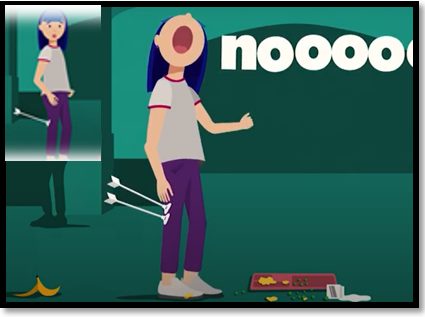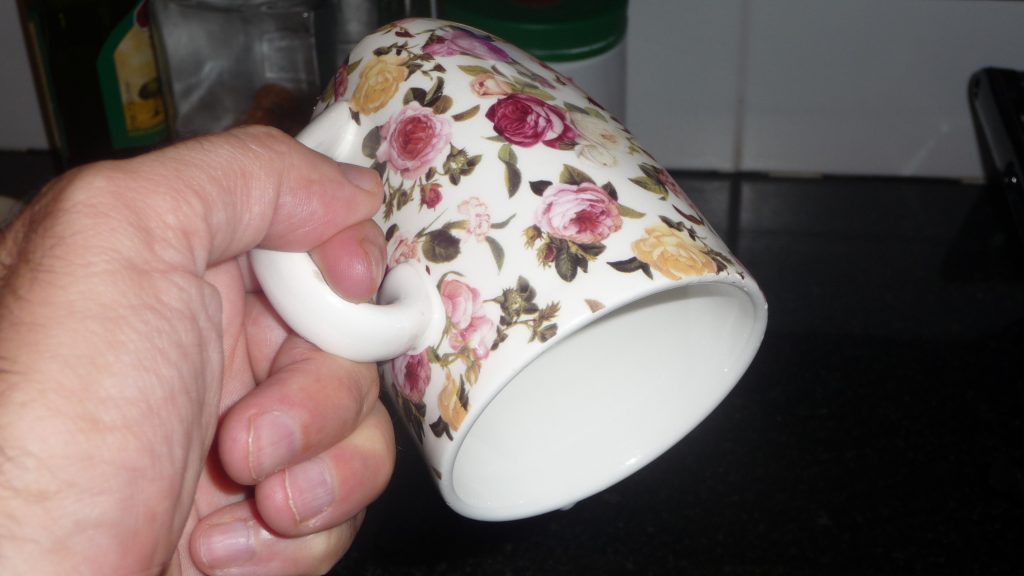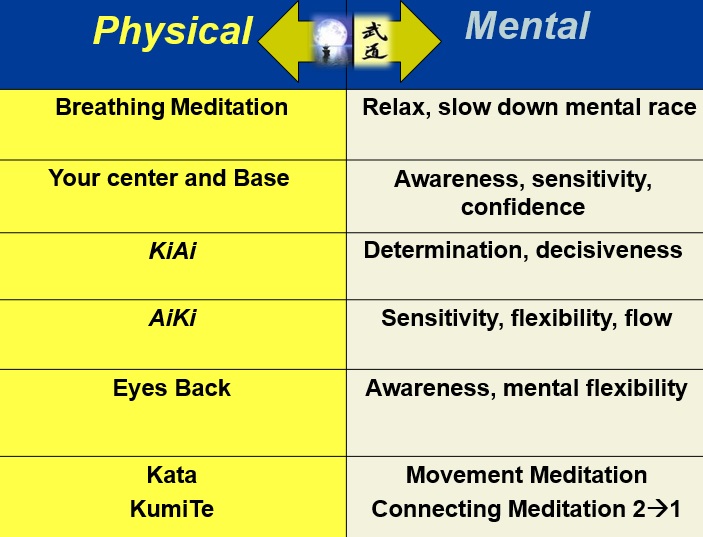The 2 arrows
Pain is certain, Suffering is optional

Pain vs. Suffering
There is pain in human life as part of our actual existence in this world – this realization is symbolized by the first arrow, in the well-known Buddhist parable.
This first arrow or pain is unavoidable and hits us throughout our life circumstances such as illness, loss, physical pain and death.
On the other hand, the additional suffering that follows the initial pain, which is associated with the second arrow and more arrows that usually come, is largely “optional self-caused” – unnecessary layers of suffering that we add to the initial pain with our inner voice giving constant opinion and interpretation of life events such as – ‘Oh my God, why? It will never end! Why me? Again? I cannot take this anymore! I am a victim of…’
In the displayed image the girl has slipped over a banana and dropped her tray – 1st arrow pain (top left small image).
Unwilling to accept the situation (what is) her resistance is manifested by crying Nooooooooo… thus inflicting unnecessary additional suffering – 2nd arrow.
What can you do? How to prevent the second arrow’s unnecessary suffering?
Avoid adopting a ‘stone’s approach’ – rigid, seemingly unaffected by environmental events so as not to feel or be harmed by external circumstances beyond my control. Rather, be like water or like the wind that is in constant flow and adaptation – encountering a rock (1st arrow’s Pain) it immediately flows on while accepting and adapting to what is.
Understand and accept world’s nature of constant change with mutual influence between all beings.
Instead of trying to build an ineffective shielding wall of detachment and an attitude of indifference toward the world, learn to live and flow with what is through understanding and accepting the “rules of the game” governing this world and your existence.
When pain comes look it in the eyes, if there is anything to do to reduce it – do and if not accept, either way avoid adding ‘your stories’ that bring extra arrows and unnecessary suffering.
“Physical 2 Mental”
The below table demonstrates some of the “Physical Tools” provided during the BuDo-Way sessions and the corresponding mental affect these have. As you acquire those practical tools you should be able to apply those any time as needed within actual life situations modifying your mental state at will and thus taking control over your performance, success and ultimately your life.
Buddhist Sunyata & KaraTe
Buddhist Sunyata can be understood as the realization that no entity or being has its own separate, independent or permanent nature. Rather all beings are inter-related through mutual influence and in an on-going flux of constant change.
BuDo concept of KumiTe can serve as an example or analogy. When two martial artists face each other in KumiTe they become one. There is no separate independent existence of each, rather the flux of mutual influence where each is aware, responsive and constantly adjusting to the other.
This is the deep meaning of the Japanese word Kara (empty) of KaraTe-Do where each practitioner becomes empty of separate independent existence symbolically represented by the term KumiTe (integrated hands).
It is all about Breath
Here is the whole concept at brief as manifested in four aspects of breathing:
Conscious observation of our breath can serve as an analogy and teach us deep lessons about the essence of our existence as a seemingly “independent self” distinct from what we perceive as an external world and with which we are in an on-going continuous interconnection.
1. By its very nature, the breath connects and connects us to the outside world through the air we breathe in and exhale in the continuous interplay of acceptance and giving.
2. It’s all as personal as my breath actually can’t decide – I have to breathe (even if I can avoid it for a short time)
3. The aspiration that is an acceptance process is carried out without resistance – I get “what is” out there, which the world gives me without filtering-labeling-labeling “air is air” and I must accept it for my existence.
4. Exhale without holding, I give up without holding on “it’s mine”.
Breath in martial arts:
1. Breathing is the bridge that connects the mental to the physical – between intention and image for muscle and movement action, technique. In this sense, there is no breathless movement.
2. Respiration controls muscle expansion and contraction when in general inhalation is correlated with dilation and exhalation with muscle contraction.
3. Increasing and accelerating the energy is done by creating controlled pressure breathing to the stand base and channeling the soil reaction along the acceleration chain in the line – the technique.
4. The KiAi sound often associated with the martial arts is exhilarated, allowing for focus, acceleration and prevention of energy escape at the time of the target, as well as the preparation or potential for a continuing and mental technique to remove doubt, hesitate or fear of failure while mobilizing general mental Given with complete determination.
5. With the help of breath, we connect to the opponent’s rhythm in order to respond in a timely manner with the small profit that he unintentionally allows and beyond, affecting and creating an opportunity while implementing strategy and risk management.
Now go out and learn how to apply the above breathing principles in daily life to improve self-awareness, inner peace, steady feelings of stress, and reduce your dependence on inner happiness in external events from a deep insight into your interactions and constant interplay with the environment and the world.
HoShin

The ability and acquired skill of maintaining “Peaceful Mind” during stressful situations, when at doubt, under uncertainty and within a conflict situation are of great value in many life situations and specifically beneficial at this covid-19 challenging time. The BuDo-derived “Ho-Shin” concept is key and an effective tool in handling such situations.
In BuDo as well as in many actual life situations the ability to give everything to a given task at a given moment is critical as it enables us to fully be within the situation recruiting all human mental-physical faculties for best performance. Furthermore, and surprising for many through such complete determination removing all doubt and hesitation we create space for mental flexibility and efficient adaptation to varying situations as represented by the Ho-Shin concept.
Life calls upon us to constantly make decisions – from relatively small everyday choices to bigger decisions including a change of marketing strategy given covid-19 driven changing economy, making financial investments, choosing a career path, changing place of residence or getting married.
Ho-Shin stands for “give everything to remain full” – making important decisions you should certainly consider carefully, assess the situation – odds versus risks, consult the wise and experienced and avoid unnecessary haste. Yet, once decided and for that moment give everything with no doubt, hesitation or fear of failure.
In other words, once decided “give your heart to it” as doing things “half-heartedly” you are always half in the past half in future – never fully here and now.
Now you might ask – don’t I lose my flexibility and ability to adapt and adjust if I do things with such complete determination? Many people assume that complete determination contradicts and cannot coexist with flexibility and adaptation so they go “half way” doing things half-heartedly presumably keeping their options open should conditions change calling for a new direction – decision – action. This approach leads to an internal conflict – “I do it yet not fully as I am keeping my options”.
Ho-Shin stands for the opposite – it suggests that by doing something fully, being completely at one with your action with no doubt, hesitation, fear of mistake or failure you create mental space and thus you shall not only execute current task better but actually be more flexible to instantaneously and spontaneously adjust to the new unexpected situation or condition.
While it is important to gather information, plan ahead assessing various options and setting a corresponding strategy, life and covid-19 teaches us that more often than not actual events shall not unfold exactly as planned, hence the need to acquire the skill of (instantly) adjusting to unplanned at times unfamiliar scenarios avoiding rigid “emotional attachment” to our original plans.
In BuDo as well as real life and business situations we assess others and set corresponding strategy yet often the situation evolves in unexpected ways so we must adjust in real time to new conditions and spontaneously act accordingly. Adopting a “Ho-Shin approach” is key here as it appears (surprisingly to many) that it is by giving everything to a current task removing all doubt, hesitation or mistake concerns that we can actually create the mental space to efficiently adjust to new situations.
The great Master Nishiyama sensei used to give the analogy of a glass of water being turned upside down – if you do it slowly, cautiously “keeping your options open” all water shall drop and the glass shall remain empty yet if you do it promptly with no hesitation giving everything to it, the glass (you) shall remain (at least partially) full.
Hence the lesson of – Give everything to you remain full taken from BuDo to be applied in your life.
Summary
In your personal as well as business life you should think, consider, consult and assess possible decision options yet once decided (for that moment) act with Ho-Shin spirit avoiding any doubt, hesitation or failure concerns.
This approach shall let you be at your best executing your decision as well as effectively adjust to new unexpected situations within an ever changing dynamic reality.



